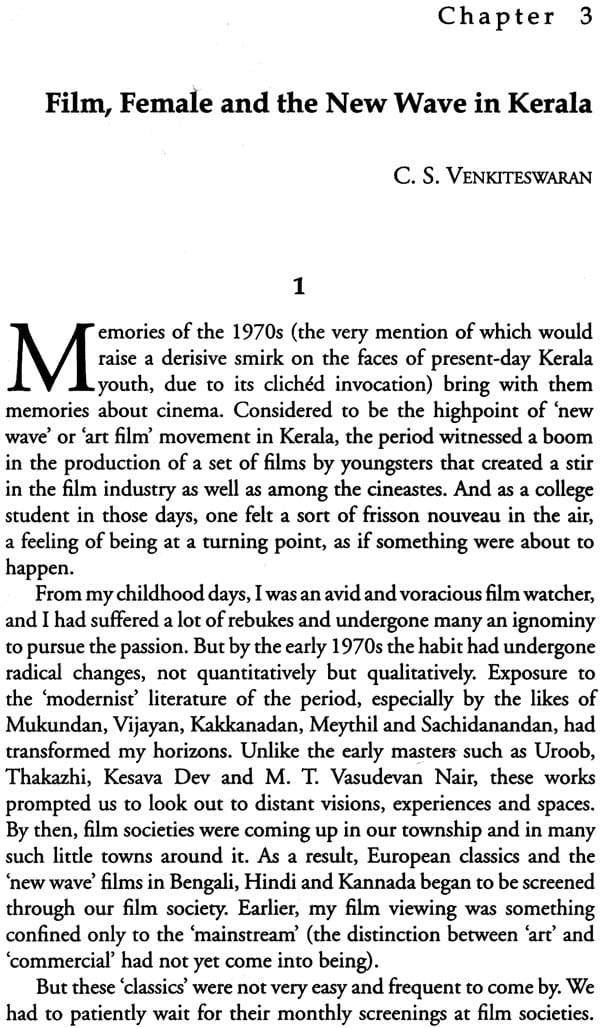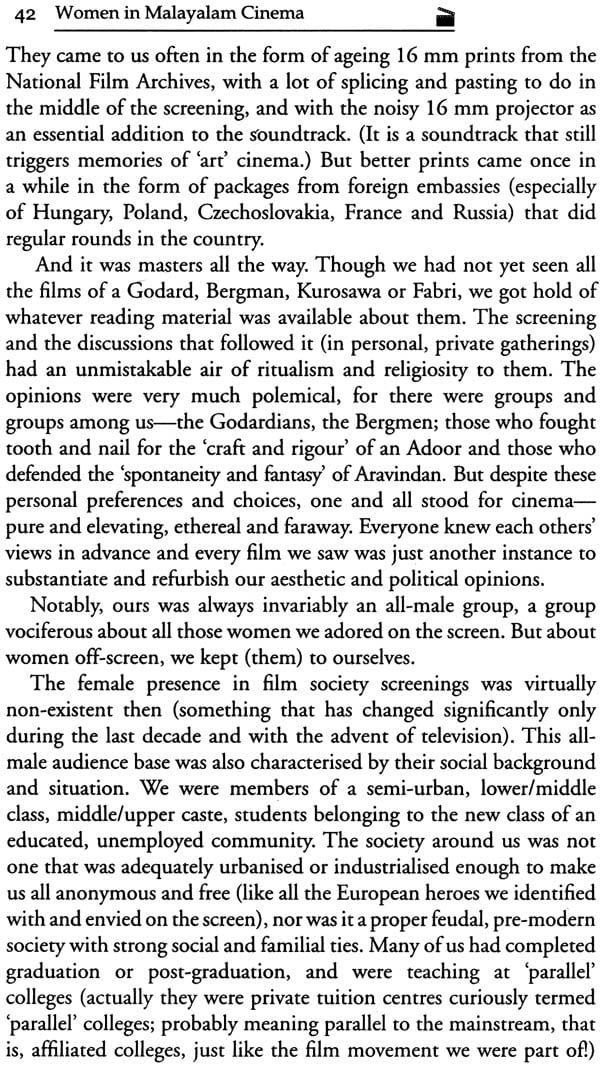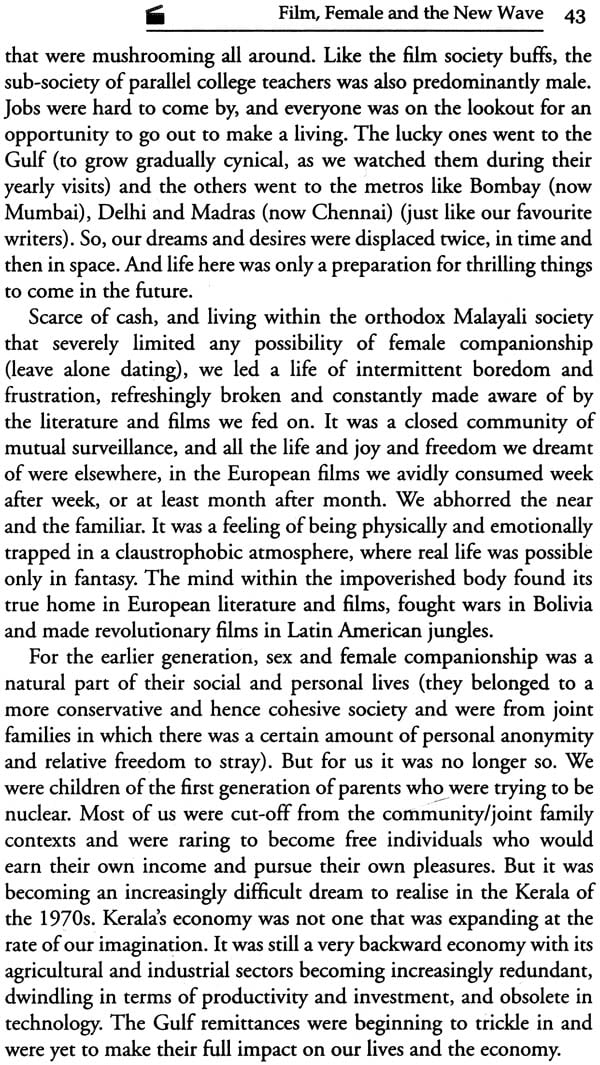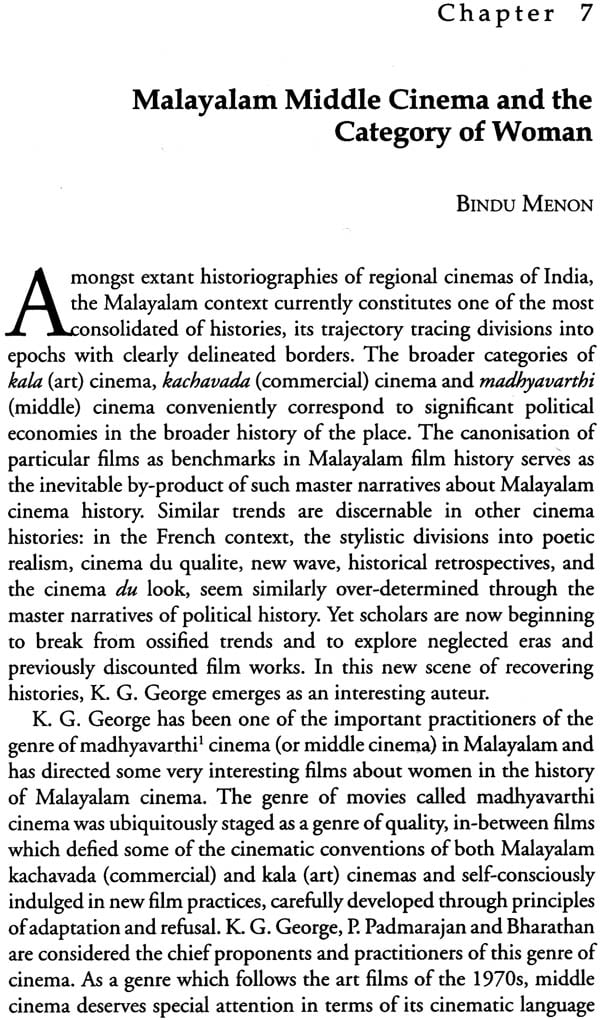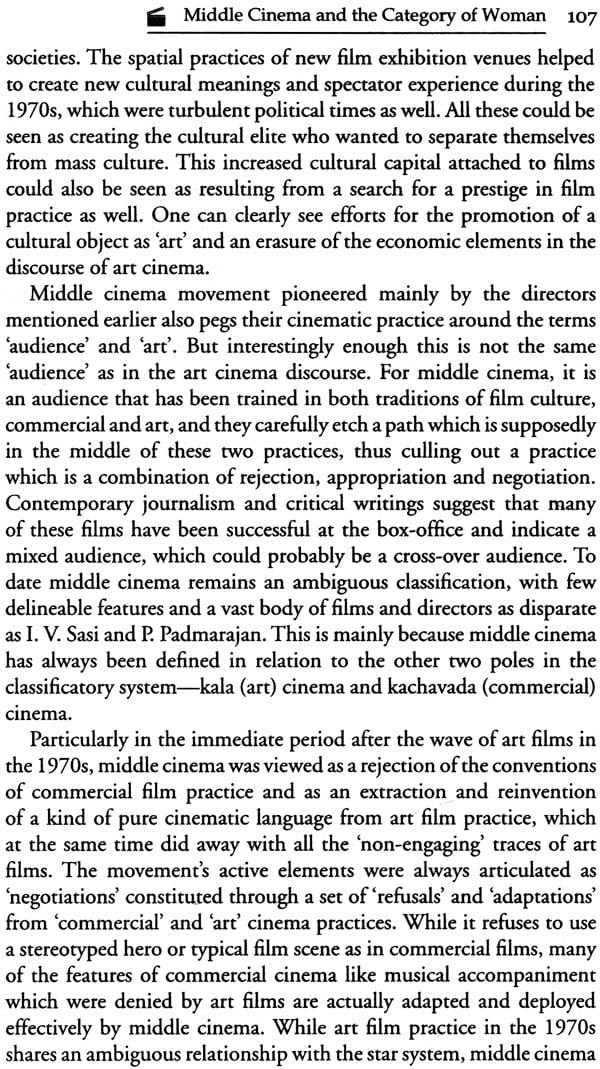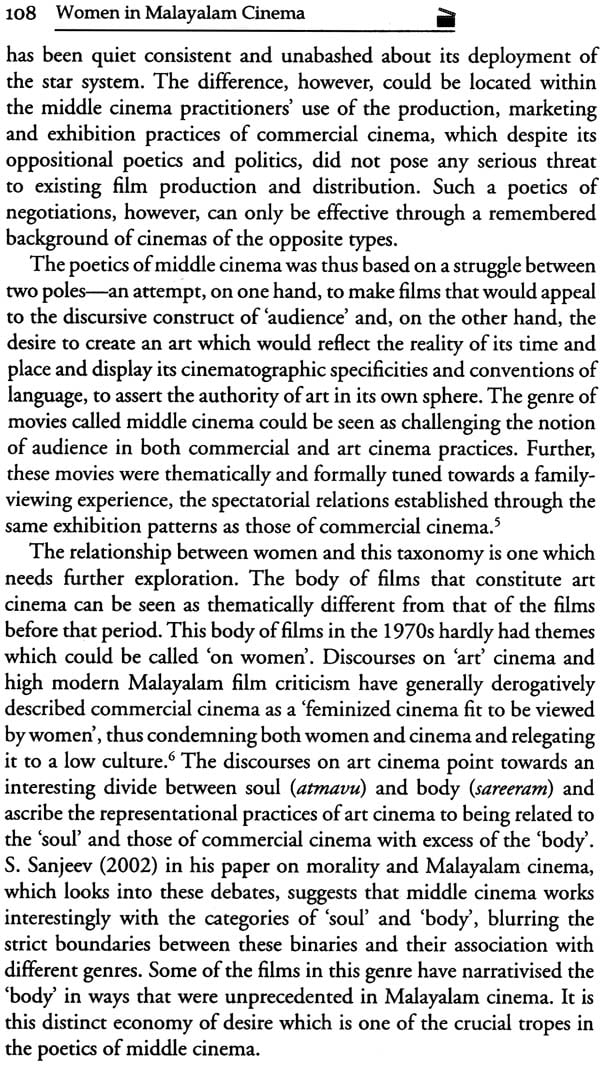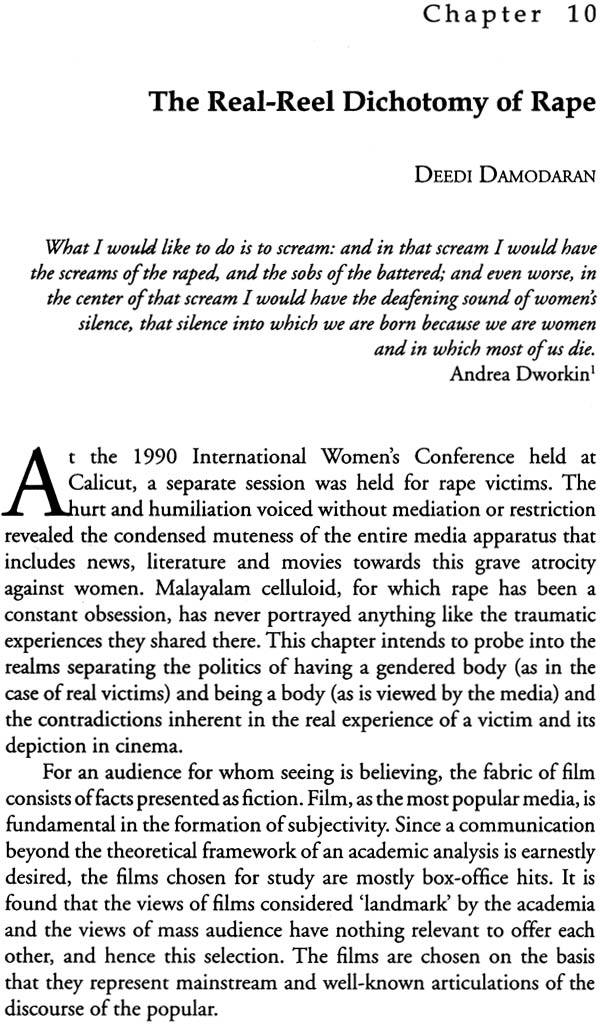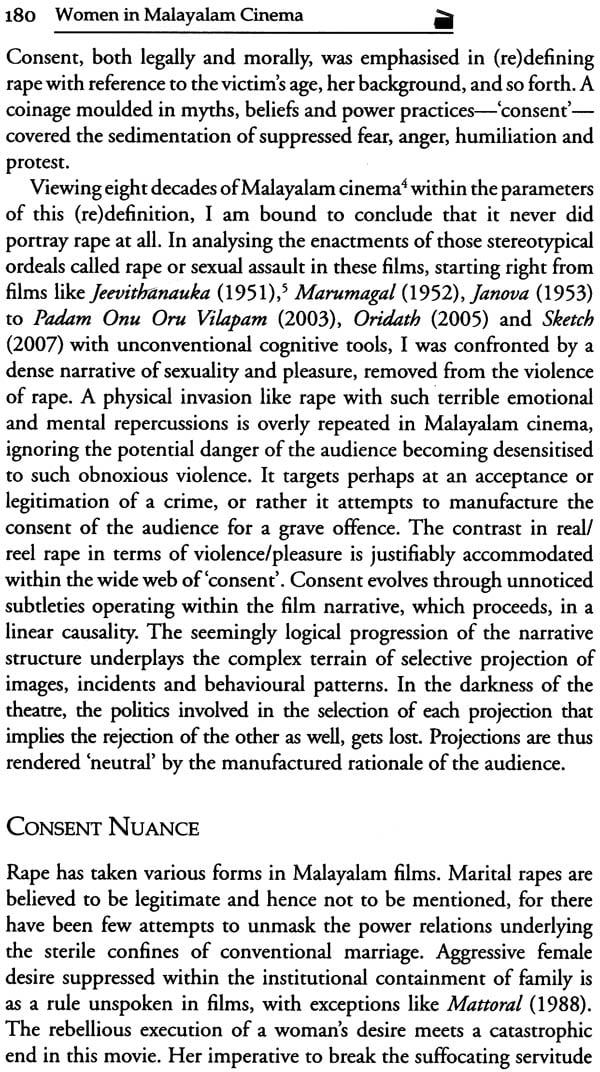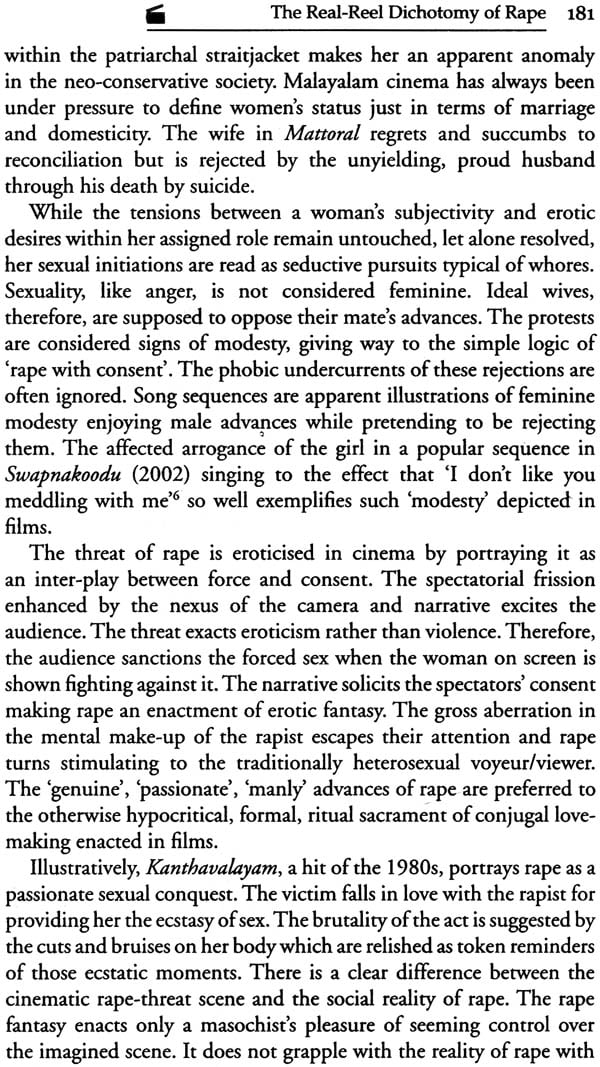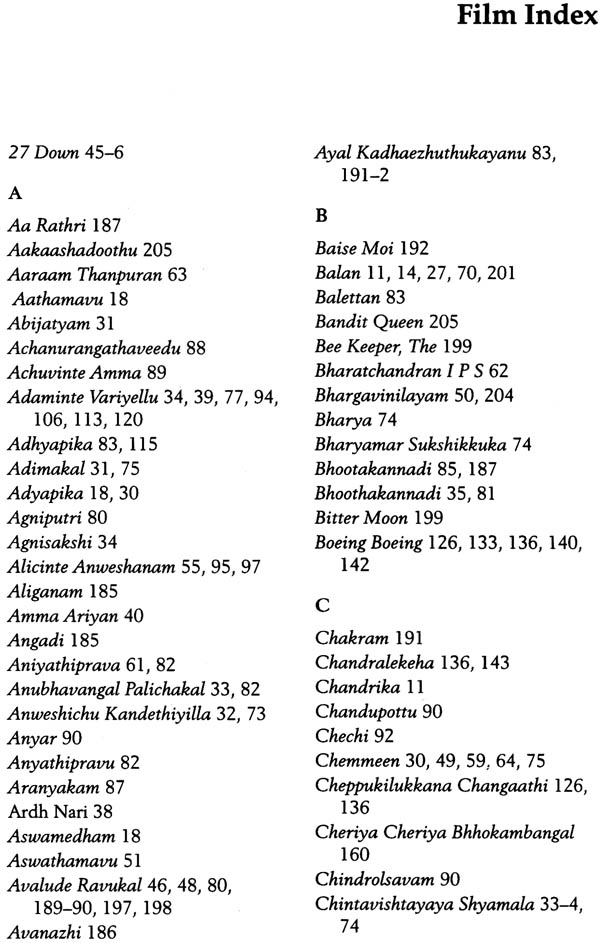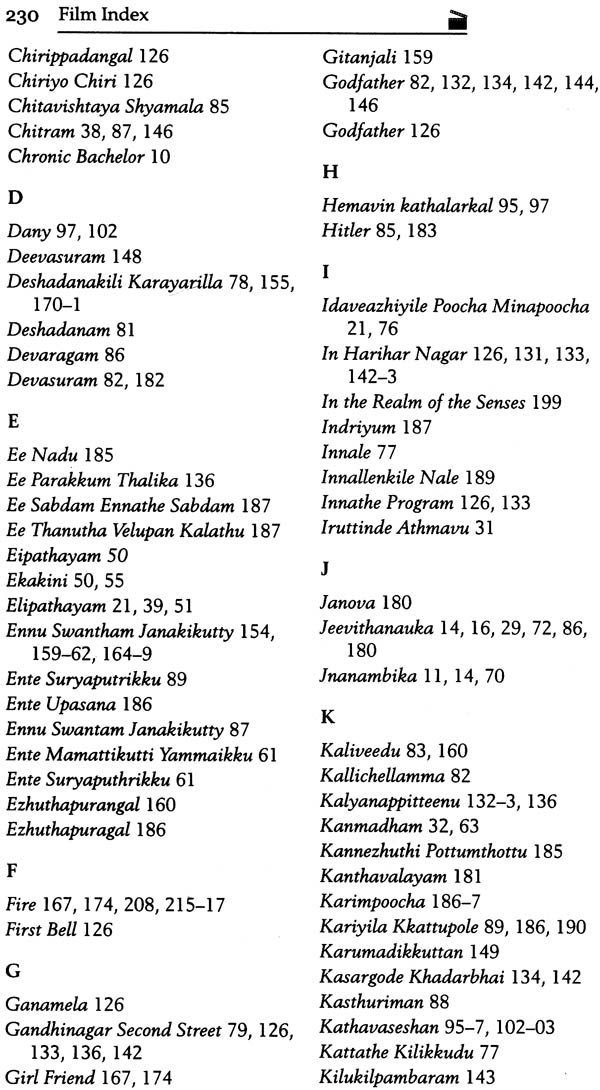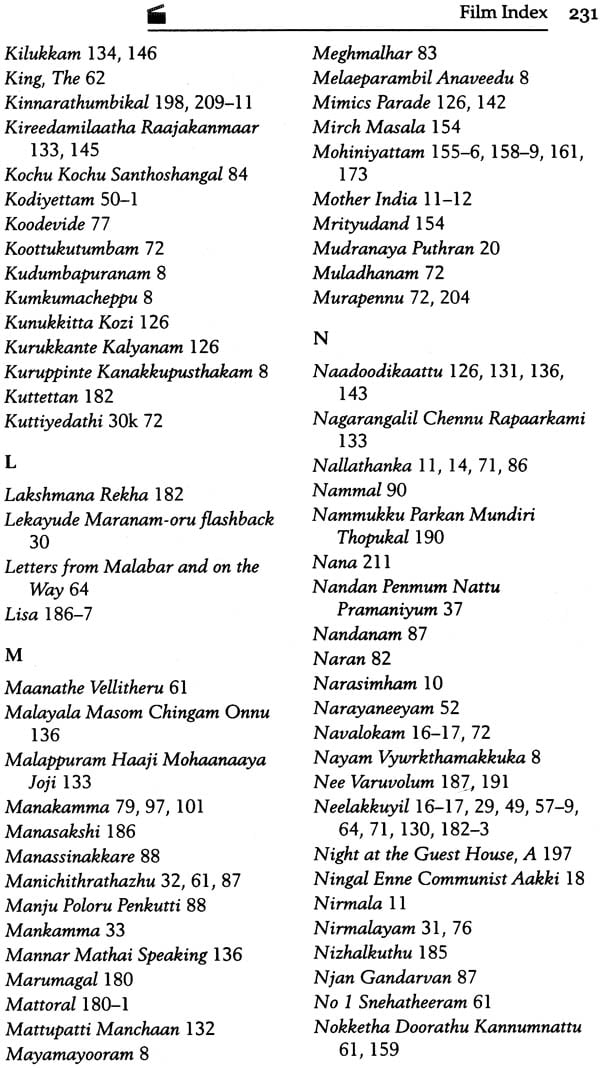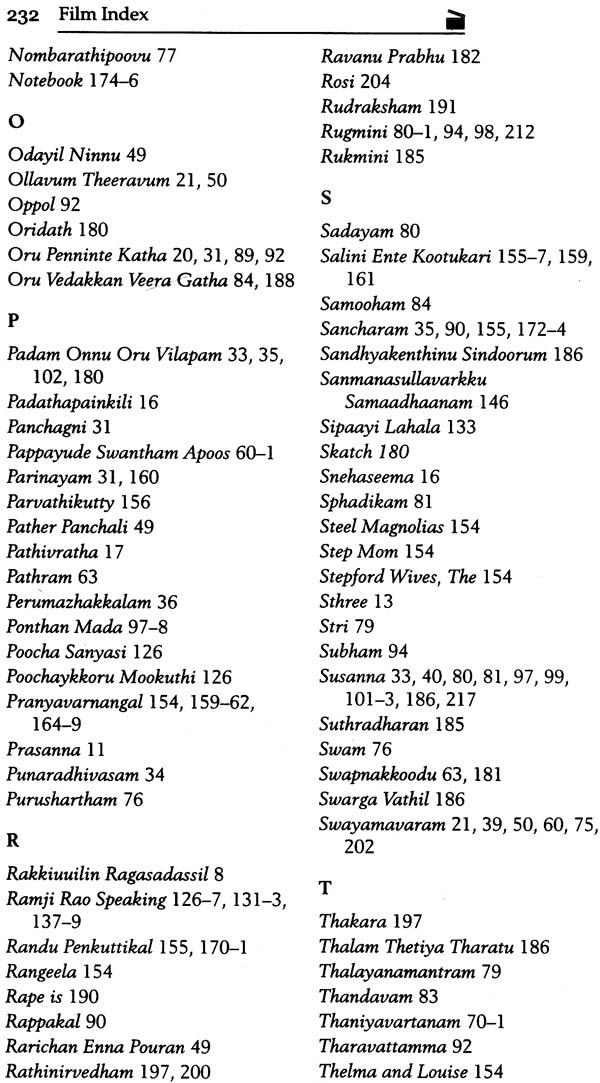
Women in Malayalam Cinema
Book Specification
| Item Code: | NAG010 |
| Author: | Meena T. Pillai |
| Publisher: | Orient Blackswan Pvt. Ltd. |
| Language: | English |
| Edition: | 2010 |
| ISBN: | 9788125038658 |
| Pages: | 252 |
| Cover: | Hardcover |
| Other Details | 9 inch X 5.5 inch |
| Weight | 420 gm |
Book Description
About the Book
Drawing on contemporary critical theories I and academic debates, Women in Malayalam Cinema: Naturalising Gender Hierarchies analyses Malayalam cinema and the question of women from different perspectives. In its focus on woman-cinema interface, as depicted in a century of Malayalam cinema, this book addresses a wide range of themes crucial for a nuanced understanding of Malayalam film culture, gender stereotyping, marriage and family, the aftermaths of matriliny, caste and gender relations, hegemonic patriarchy, female \ friendships and soft porn. These diverse concerns are held together by a key focal point: the paradox of regressive modernisation in Kerala's cultural politics. The widely discussed and extolled 'Kerala Model' has yielded much grist to the statistical mills of Left-liberal developmental sociologists. However, questions concerning more precise connections between the impressive developmental indices and the cultural politics that shape the lives and subjectivities of women within this 'model state' have remained relatively unexplored. Deconstructing patriarchal dominance in Malayalam cinema, mainstream and avant garde, this collection elucidates how films offer stereotypical images of women conforming to subordination. Be it Vigathakumaran (1928), or Sthree (1950), or a more recent one Achanurangathaveedu (2005). there is a constant failure across films to look beyond the portrayal of woman as someone 'who loves to cook and clean. wash and scrub. shine and polish for her man'. This volume. a first of its kind on Malayalam cinema. has diverse contributions from Litterateurs. film critics and screenwriters. and will be of interest to scholars of film. media and gender studies.
About the Author
Meena T. Pillai is Reader at the Institute of English. and Director. Centre for Comparative Literature. University of Kerala, Thiruvananthapuram.
Introduction
Kerala occupies a unique position in the socio-cultural and political map of India and is way ahead of many other states in terms of social development indicators like birth and death rates, infant mortality, maternal mortality, sex ratio, fertility rate, economic growth and literacy. Of late the 'Kerala Model' of development has generated much critical interest worldwide owing to its peculiar pattern of a 'developmental conceit', which records accelerated social achievements and high development output on a rather depleted and shaky economic base with minimal agricultural and industrial growth. These high social development indices have given rise to the 'myth of Malayali women' as enjoying higher status than their counterparts elsewhere in the country, especially in view of the fact of high female literacy in the state. This myth has been augmented and nurtured by evidence that matrilineal forms of kinship patterns were prevalent among certain communities in Kerala. However, what is to be taken into consideration here is that between 1896 and 1976 as many as twenty legislations were enacted in the erstwhile states of Travancore, Cochin and Malabar, and later on in the current state of Kerala (which is an amalgamation of the earlier princely states), in order to gradually revoke the legal framework of matriliny (Eapen and Kodoth 2001). These legislations sought to radically change the structure and practices of families through changes in marriage, inheritance and succession patterns that were largely patrifocal and aimed at weakening women's access and control over inherited resources, while at the same time curtailing their power over their own lives. The high level of female literacy and employment, one-third reservation of seats in local governance bodies, high sex ratio and low fertility rates together with high female physical health achievements indicate that the women of Kerala have definitely achieved a certain amount of social and political empowerment in the public domain. However, the alarming rise in the rate of female suicide, domestic violence, dowry-related issues, gender-based crimes and greater prevalence of mental disorders among women also point towards a fall-back in the position of women within the domestic sphere. Apparently, it is through bargaining and compromising their autonomy and agency within the private sphere that women have been able to negotiate their way into the public domain. Thus, one can safely surmise that it is through double enslavement and reiterative identification with familial terms and ideals that the women of Kerala have managed to acquire a role and visibility in the paid workforce of the state. But here again, paradoxically enough, their pay cheques can hardly ever be encashed for economic freedom or social mobility.
It is no wonder then that though Kerala is one of India's foremost states in terms of socio-economic status, health conditions and general standards of living, where social history has recorded liberal thought, progressive movements and emancipatory struggles at far higher levels than elsewhere in the country, 'feminism' here remains, in popular parlance, a word evoking derogatory and hostile reactions. Though there have been movements and agitations by women's groups and collectives for equality and gender justice, they have been by and large issue-based and have not really sought to address basic issues such as women's subordination within the family or reframing the parameters of man-woman relation within which is located the main issue of women's oppression. Feminism, perceived as a threat to the bourgeois family, has forced many women to steer clear of the label and adopt a defensive and conservative stance when forced to confront gender reform issues at any level whatsoever.
Kerala's peculiar native brand of what I would call a 'liberal patriarchal pseudo-feminism' has provided women a semblance of emancipation with equal legal and property rights, the right to education and other rights guaranteed by the Constitution. Yet education and social grooming have been kept at conservative levels with continuing emphasis on the 'feminine mystique' teaching girls that they are essentially wives and mothers. At no level of education has any attempt been made at raising consciousness to create women of independent thought and action. So the family continues to be the unchallenged bastion of patriarchy, where inspite of the so-called political and legal equality women's subordination begins, brews and spills over to other societal structures at large. Even as a large number of women from the middle and working classes step out of their homes to make a livelihood, there is a visible hurry to get back and re-emphasise their own roles as mothers, wives and daughters-in-law as though to gain sanction and sanctimony for their further forays into the outer world. In this context one can perceive an imperative need in Kerala's society today to look at and integrate representations of women, especially in the wake of knowledge of the problematic nature of representation itself, which can only be incomplete and partial interpretations rather than 'objective' description of 'reality'. In a world where 'femininity' is forced upon women, the least they can do is to be vigilant in their representations of themselves and how they read and decode such representations by others. It is in this context that I propose to situate the emergent discourse of cinema in Kerala in the early 1940s and analyse how it has sought from then till now, in varying degrees, to consolidate and reinforce the 'patrifocal' ideology of a society that was and is continually struggling to efface a matrilineal past by pegging down with vigour the contours of normative femininity that deny women their identity.
This book began from a question I often asked myself-why does the nationally and internationally acclaimed Malayalam cinema fail to represent women's experiences from their varied and different social locations? This question naturally leads to the problem of defining/framing Malayalam cinema and how it speaks for/of the cultural/national identity of the Malayali. The category 'Malayalam cinema' by its territorialisation makes cinema stand for a sub- national/regional identity, making it a means by which Malayalies can represent themselves. By probing how 'Malayaliness' is imagined and how it shapes objects and subjects in the contemporary socio- cultural life of Kerala, it becomes possible to re-territorialise Kerala not as an exclusive and clearly demarcated geographical and political space, but as one where fluid subjectivities are constantly remapping themselves.
Contents
| Acknowledgements | ix | |
| Part I: Introduction | 1 | |
| 1 | Becoming Women: Unwrapping Femininity in Malayalam Cinema | 3 |
| Part II: Historical Mappings of Gender | 25 | |
| 2 | Gender Equations in Malayalam Cinema | 27 |
| 3 | Film, Female and the New Wave in Kerala | 41 |
| 4 | Engendering Popular Cinema in Malayalam | 57 |
| Part III: representing women? The Sexual Contract | 67 | |
| 5 | Marriage and Family in Malayalam Cinema | 69 |
| 6 | Women of a Different Republic | 92 |
| 7 | Malayalam Middle Cinema and the Category of Woman | 105 |
| Part: IV: Contemporary Crossings: Foiled Promises | 123 | |
| 8 | The 'Laughter-Films' and the Reconfiguration of Masculinities | 125 |
| 9 | Women's Friendships in Malayalam Cinema | 154 |
| 10 | The Real-Reel Dichotomy of Rape | 178 |
| 11 | Soft Porn and the Anxieties of the Family | 194 |
| Bibliography | 221 | |
| Film Index | 229 | |
| General Index | 234 | |
| Notes on Contributors | 241 |
